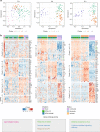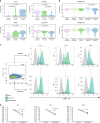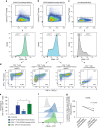Invasive Salmonella exploits divergent immune evasion strategies in infected and bystander dendritic cell subsets
- PMID: 30451854
- PMCID: PMC6242960
- DOI: 10.1038/s41467-018-07329-0
Invasive Salmonella exploits divergent immune evasion strategies in infected and bystander dendritic cell subsets
Abstract
Non-typhoidal Salmonella (NTS) are highly prevalent food-borne pathogens. Recently, a highly invasive, multi-drug resistant S. Typhimurium, ST313, emerged as a major cause of bacteraemia in children and immunosuppressed adults, however the pathogenic mechanisms remain unclear. Here, we utilize invasive and non-invasive Salmonella strains combined with single-cell RNA-sequencing to study the transcriptome of individual infected and bystander monocyte-derived dendritic cells (MoDCs) implicated in disseminating invasive ST313. Compared with non-invasive Salmonella, ST313 directs a highly heterogeneous innate immune response. Bystander MoDCs exhibit a hyper-activated profile potentially diverting adaptive immunity away from infected cells. MoDCs harbouring invasive Salmonella display higher expression of IL10 and MARCH1 concomitant with lower expression of CD83 to evade adaptive immune detection. Finally, we demonstrate how these mechanisms conjointly restrain MoDC-mediated activation of Salmonella-specific CD4+ T cell clones. Here, we show how invasive ST313 exploits discrete evasion strategies within infected and bystander MoDCs to mediate its dissemination in vivo.
Conflict of interest statement
The authors declare no competing interests.
Figures








Similar articles
-
Nsp1α of Porcine Reproductive and Respiratory Syndrome Virus Strain BB0907 Impairs the Function of Monocyte-Derived Dendritic Cells via the Release of Soluble CD83.J Virol. 2018 Jul 17;92(15):e00366-18. doi: 10.1128/JVI.00366-18. Print 2018 Aug 1. J Virol. 2018. PMID: 29793955 Free PMC article.
-
CXCL4 Exposure Potentiates TLR-Driven Polarization of Human Monocyte-Derived Dendritic Cells and Increases Stimulation of T Cells.J Immunol. 2017 Jul 1;199(1):253-262. doi: 10.4049/jimmunol.1602020. Epub 2017 May 17. J Immunol. 2017. PMID: 28515281
-
Antigen-specific induced T regulatory cells impair dendritic cell function via an IL-10/MARCH1-dependent mechanism.J Immunol. 2013 Dec 15;191(12):5875-84. doi: 10.4049/jimmunol.1301693. Epub 2013 Nov 11. J Immunol. 2013. PMID: 24218453 Free PMC article.
-
Mechanisms used by virulent Salmonella to impair dendritic cell function and evade adaptive immunity.Immunology. 2012 Sep;137(1):28-36. doi: 10.1111/j.1365-2567.2012.03614.x. Immunology. 2012. PMID: 22703384 Free PMC article. Review.
-
Molecular Mechanisms Used by Salmonella to Evade the Immune System.Curr Issues Mol Biol. 2018;25:133-168. doi: 10.21775/cimb.025.133. Epub 2017 Sep 6. Curr Issues Mol Biol. 2018. PMID: 28875943 Review.
Cited by
-
Understanding the pathogenesis of infectious diseases by single-cell RNA sequencing.Microb Cell. 2021 Aug 4;8(9):208-222. doi: 10.15698/mic2021.09.759. eCollection 2021 Sep 6. Microb Cell. 2021. PMID: 34527720 Free PMC article. Review.
-
Stepwise evolution of Salmonella Typhimurium ST313 causing bloodstream infection in Africa.Nat Microbiol. 2021 Mar;6(3):327-338. doi: 10.1038/s41564-020-00836-1. Epub 2020 Dec 21. Nat Microbiol. 2021. PMID: 33349664 Free PMC article.
-
Dual RNA sequencing reveals dendritic cell reprogramming in response to typhoidal Salmonella invasion.Commun Biol. 2022 Feb 4;5(1):111. doi: 10.1038/s42003-022-03038-z. Commun Biol. 2022. PMID: 35121793 Free PMC article.
-
Targeting deubiquitinating enzymes (DUBs) and ubiquitin pathway modulators to enhance host defense against bacterial infections.bioRxiv [Preprint]. 2025 Jan 29:2025.01.27.635188. doi: 10.1101/2025.01.27.635188. bioRxiv. 2025. PMID: 39975367 Free PMC article. Preprint.
-
Salmonella cancer therapy metabolically disrupts tumours at the collateral cost of T cell immunity.EMBO Mol Med. 2024 Dec;16(12):3057-3088. doi: 10.1038/s44321-024-00159-2. Epub 2024 Nov 18. EMBO Mol Med. 2024. PMID: 39558103 Free PMC article.
References
-
- Hendriksen RS, et al. Global monitoring of Salmonella serovar distribution from the World Health Organization Global Foodborne Infections Network Country Data Bank: results of quality assured laboratories from 2001 to 2007. Foodborne Pathog. Dis. 2011;8:887–900. doi: 10.1089/fpd.2010.0787. - DOI - PubMed
Publication types
MeSH terms
Substances
Grants and funding
- MR/M00919X/1/MRC_/Medical Research Council/United Kingdom
- G84/6443/MRC_/Medical Research Council/United Kingdom
- MC_UU_00016/15/MRC_/Medical Research Council/United Kingdom
- MC_UU_12009/16/MRC_/Medical Research Council/United Kingdom
- MC_PC_15065/MRC_/Medical Research Council/United Kingdom
- MR/L006340/1/MRC_/Medical Research Council/United Kingdom
- MR/S036377/1/MRC_/Medical Research Council/United Kingdom
- WT_/Wellcome Trust/United Kingdom
- MC_UU_00008/7/MRC_/Medical Research Council/United Kingdom
- MC_UU_12010/7/MRC_/Medical Research Council/United Kingdom
- NIHR-RP-R3-12-026/DH_/Department of Health/United Kingdom
LinkOut - more resources
Full Text Sources
Molecular Biology Databases
Research Materials

